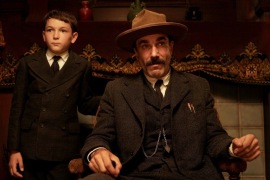 THERE WILL BE BLOOD
THERE WILL BE BLOOD
As much as I adored Paul Thomas Anderson's There Will Be Blood - and I adored nearly every second of its 150-minute running length - it's the type of movie that I hate composing a review for, because no matter what I write, I know it won't come close to doing the achievement justice.
I could easily rave about Anderson's exquisite compositional skills, and his genius for cinematic shorthand - his acuity at giving us exactly the visual and aural detail needed for gut-level understanding of character and situation. I could describe how effortlessly Anderson establishes a sense of time and place, and his unerring sense of tempo; I could discuss how beautifully the writer/director's images intertwine with Jonny Greenwood's evocative score, and the continued amazement that is the movie's star, Daniel Day-Lewis.
But all that would only get us through the film's first 15 minutes, and that's before the characters even speak. Once they do, There Will Be Blood moves with a momentum and force that is, quite simply, overwhelming, and the result is as viscerally, emotionally grand an epic as this country has produced in decades. Even those of us who've been knocked out by Anderson's and Day-Lewis' talents in the past may not be prepared for the strength of their collaboration here; scene by scene, minute by minute, the film is supremely, shatteringly alive.
Like most great movies, There Will Be Blood grows more fascinating and trenchant the more you dwell on it, and also like most great movies, it's precariously difficult to explain what the film is about. The simplistic description is that it's "about" turn-of-the-20th-Century oilman Daniel Plainview (Day-Lewis), who, alongside his adopted son H.W. (Dillon Freasier), travels southern California in search of untapped properties, and whose avarice and almost maniacal determinism lead to perilous clashes with landowners, tycoons, and the region's burgeoning evangelism, embodied by a wholly untrustworthy preacher (Paul Dano).
Yet a routine plot synopsis - much like a 600-word review - can't begin to describe what There Will Be Blood is about; thematically, it feels like it's about everything, from the age-old battle between commerce and religion to the tenuous bond between fathers and sons to the horrifying underbelly of American entrepreneurship. (You might find its themes haunting you for days.) Yet Anderson, with astonishing grace, never overstates his intentions, and continually allows you to make discoveries for yourself: the thoughtful manner in which H.W. pauses before he speaks, practicing - as he has no doubt learned - to only say what he means; the repeated sight of Plainview asleep on hard, wooden surfaces, only comfortable when curled up like a dog.
Working with, among many brilliant collaborators, cinematographer Robert Elswit and production designer Jack Fisk, Anderson creates an aesthetically remarkable and wildly entertaining vision of American corruption at its most base. But it's entirely possible that the entire endeavor would have capsized without Daniel Day-Lewis. Has any screen narrative ever featured, in its leading role, a character so unequivocally frightening yet so empathetic, so monstrous yet so moving? Even if you were inclined to, there's no point in There Will Be Blood at which you can turn from Day-Lewis' staggeringly captivating portrayal; his gloriously rich, unapologetically theatrical performance seems the physical embodiment of both the American dream and the American nightmare. I'm hoping, and expecting, that if one of Day-Lewis' competitors for the Best Actor Oscar winds up winning, he'll have the good sense to be embarrassed.
 U2 3D
U2 3D
Just how impressive is the 3D technology on display in the concert film U2 3D? When some friends and I caught the movie at the Putnam Museum & IMAX Theatre last week, a couple of viewers in the row ahead walked in front of us on their way to the lobby, and when they did - I swear to God - you couldn't tell the difference between them and the figures on screen. Seamlessly composed from a trio of live performances during the band's recent Vertigo tour, and directed by Catherine Owens and Mark Pellington, U2 3D is a miraculous piece of work - a concert experience of such command and mind-blowing technical invention that you feel you can't possibly take in all the sights and sounds you're engulfed in. For a U2 fan, the movie is bliss - Bono's impassioned wailing and staggering stage charisma feel nearly, newly revelatory, and the sound quality is superb - but the film is more than worth seeing for the jaw-dropping clarity of the images alone. The filmmakers bring you thrillingly close to the throngs of concertgoers (you can all but reach out and grab their Zippos), and when the crowd jumps up and down to the music's rhythm, the screen seems to literally pulse; U2 3D might be the most tangible movie-going experience I've ever been part of. After 85 minutes, I left the theatre simultaneously exhilarated and wiped out, and more than ready for another viewing.










